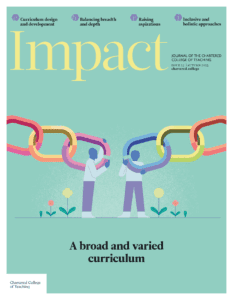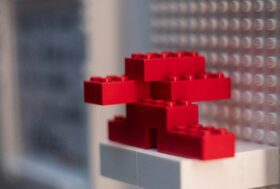From play to progress: How continuous provision in Key Stage 1 creates pathways to success for every learner

EMMA LEWRY, EMMA LEWRY LTD, UK
ELLEN PARKER, STOKE PRIMARY SCHOOL, UK
Formal learning has become the dominant pedagogical approach in Key Stage 1 across England, prioritising early literacy and numeracy skills in a more structured setting. However, as cohorts of children evolve, shaped by changing societal, developmental and emotional contexts, so too must our approaches. This transition has coincided with a growing SEND (special educational needs and disabilities) crisis, significant behaviour challenges in schools and an alarming mental health crisis among children. These trends suggest that traditional models may not adequately support the diverse developmental needs of young learners.
In light of these challenges, there is a pressing need to explore alternative, research-informed pedagogies. In response, Stoke Primary School has implemented a continuous provision approach across Year 2, offering a more flexible, play-informed model of learning. This case study tracks its implementation and impact over one academic year.
Context
Stoke Primary School is a two-form-entry, inner-city school with above-national levels of both students with EAL (English as an additional language) and SEND, and those eligible for pupil premiumAdditional funding for publicly funded schools in England to raise the attainment of disadvantaged pupils of all abilities. We are acutely aware of the complex barriers to learning that many students face. However, identifying these barriers is only the starting point – our responsibility is to actively remove them. With executive functions often disproportionately affected by socioeconomic disadvantage (Blair and Raver, 2015), we recognised the need to create more equitable learning conditions.
In recent years, we observed a challenging transition from Reception into a more formal Year 1 setting, where increased curriculum demands and prolonged time at desks often resulted in disengagement and passive learning behaviours. This wasn’t necessarily due to concerns about Year 1 outcomes, but it prompted us to reflect on whether we were truly maximising each child’s potential. In response, we reimagined Year 1 provision to better align with early years principles, embedding continuous provision to sustain engagement, foster independence and promote deeper learning. While this led to a noticeable shift in learner attitudes and outcomes, we began to question the abrupt pedagogical change that followed in Year 2. This reflection sparked a shared vision: to extend continuous provision into Year 2 and ensure greater continuity across the key stage.
Research baselines
There is extensive research into the benefits of play for learning in early childhood, yet limited evidence exists on the specific impact of continuous provision beyond the EYFS (Early Years Foundation Stage). Research underscores the critical role of play in supporting executive function development, a stronger predictor of academic success than early literacy (McClelland et al., 2014). The term ‘play’ varies widely in interpretation, making it difficult to define. It’s important to distinguish continuous provision from unstructured play: it is intentional, planned pedagogy, with environments designed to meet curriculum goals while supporting learner agency (Fisher, 2020). Our work has defined the continuous provision pedagogical approach used at Stoke as having the following characteristics:
- continuous: regular access to high-quality provision that is consistent for at least half a term
- agency: a choice of resources to access, a choice over how long for and agency over outcomes
- flexible learning routes: provision sitting alongside whole-class, small-group and one-to-one teaching opportunities, offering highly flexible and individualised routes to learning.
In exploring the research base around the themes that are present within a continuous provision approach, four key ideas emerged as especially relevant: movement, motivation, children as unique learners, and belonging and relationships. Children learn best through active, personalised and relationship-rich experiences. Movement supports cognitive processing and memory, yet many primary lessons remain sedentary, despite evidence that physical activity boosts academic performance (Mavilidi et al., 2019; Sport England, 2024). Motivation is enhanced when children are engaged through creativity, collaboration and play, fostering agency and deeper learning (Baker et al., 2023; Fenton, 2023). Each child is a unique learner, and education must nurture their individual strengths, especially for those with SEND (Article 29, UNICEF, 1989). Finally, a sense of belonging, grounded in strong adult–child relationships, is critical to learning success (McNally and Slutsky, 2018).
Case study
At Stoke Primary School, we tracked Year 2 children and staff across an academic year as they implemented a continuous provision approach. The aim of this case study is not to prove the positive impact of play-based learning on wellbeing and attainment – this is already well documented in EYFS and Year 1 – but rather to explore which specific elements contribute to that impact when carried into Year 2. Stoke holds the view that early childhood does not end with the EYFS in Reception, but continues into Key Stage 1 until children are around seven to eight years old (Fisher, 2024). This understanding informed our research design and helped to shape the lens through which we observed both learning and development.
Data collection focused on three key areas:
- movement and interaction patterns: monitored termly through systematic observations
- wellbeing and involvement: tracked termly using the Leuven Scales to assess emotional engagement and intrinsic motivation, informed by the Blackpool Transition Project research, led by Alistair Bryce-Clegg (Blackpool Council, 2009)
- skills retention: evaluated through ‘must-do’ curriculum tasks and students’ ability to revisit and reapply learning over time, with data collected on an ongoing basis as part of teacher assessment.
Findings
Since introducing continuous provision into Year 2, positive outcomes across academic, social and emotional development have been observed. Children’s wellbeing and involvement have remained high, supporting the value of extending responsive, child-centred practice beyond Year 1. These outcomes are also evident in the classroom atmosphere: children display a strong sense of belonging, inclusive practices are embedded, and personal, social and emotional development is a notable strength.
The flexibility of the environment promotes multiple routes into learning. Some children move directly from teacher input to independent application, while others choose to observe, process and plan before engaging. On average, students move between areas four to six times per session, participating in extended dialogue with peers and adults. This contrasts with traditional, static setups, where movement and interaction are more restricted.
One of the clearest academic outcomes has been improved skills retention. The structure of continuous provision allows children to revisit key concepts repeatedly in varied, meaningful contexts. Central to this are the ‘must-dos’ – carefully planned curriculum-linked tasks, where the skill or concept has already been explicitly taught. These span the curriculum and range from open-ended to more structured challenges, giving children autonomy over how and when they consolidate their learning. This approach supports long-term memory and is particularly effective for students who benefit from sustained, low-pressure opportunities to practise.
Positive learning behaviours are consistently evident. Students who may previously have required alternative provision have remained regulated, focused and actively involved within the classroom. Continuous provision appears to support not only academic progress but also improved attention and self-regulation for all learners.
Perhaps most significantly, the children appear to be happy. They arrive in the classroom with enthusiasm, collaborate confidently and show high levels of ownership over their learning. While joy should be central to any school experience, it has been especially powerful to see how continuous provision has nurtured not only academic growth, but also happiness, agency and a love of learning throughout our Year 2 cohort.
Considerations for implementation
As the project developed, many of our reflections returned to one key question: what made this work? While the impact of continuous provision on learners at Stoke has been powerful, embedding it has required ongoing dialogue, reflection and a shared vision across the school community. Based on our experience, we have identified three key considerations for schools exploring this approach:
- Leadership belief and commitment: The most important factor underpinning success has been unwavering belief from the leadership team. Continuous provision cannot be implemented as a surface-level change; it requires conviction in the pedagogy and a deep understanding of why this approach matters. Leaders must be prepared to engage with research, challenge prevailing norms and hold fast to their vision through periods of uncertainty.
- Clarity of intent in teaching and provision: For continuous provision to be meaningful, all staff, particularly teachers, must understand the purpose of each component within the learning journey. This includes clarity around when and why to use whole-class input, group work or one-to-one support, in addition to carefully planned areas of provision, linked to curriculum objectives.
- High-quality, well-planned provision: The quality and availability of provision is crucial in shaping successful learning experiences. Teachers and leaders must spend time planning, creating, reviewing and amending the provision to ensure that it meets the needs of all learners. Provision needs to be well organised and inviting, and give children opportunities to achieve their planned objectives. While some investment is needed, Stoke is an example of how, with limited space and finance, a successful learning environment can be created.
Conclusion
Continuous provision in Year 2 at Stoke has demonstrated how thoughtful pedagogy, underpinned by research and responsive leadership, can create inclusive, purposeful learning environments. As national conversations around curriculum and inclusionAn approach where a school aims to ensure that all children are educated together, with support for those who require it to access the full curriculum and contribute to and participate in all aspects of school life evolve, this case study offers a hopeful, practice-based contribution to how Key Stage 1 might better meet the needs of all learners.
- Baker S, Le Courtois S and Eberhart J (2023) Making space for children’s agency with playful learning. International Journal of Early Years Education 31(2): 372–384.
- Blackpool Council (2009) Blackpool Transition Project: Reception to Year 1. Available at: https://abcdoes.typepad.com/files/transition_document.pdf (accessed 23 June 2025).
- Blair C and Raver CC (2015) School readiness and self-regulation: A developmental psychobiological approach. Annual Review of Psychology 66(1): 711–731.
- Fenton J (2023) How might collaborative ‘learning friends’ empower children to take empowered action in their learning? Penryn Creativity Collaborative. Available at: https://penryn-college.cornwall.sch.uk/wp-content/uploads/2023/11/PCC-AR-REPORT-Fenton-2023.pdf (accessed 21 July 2025).
- Fisher J (2020) Moving On to Key Stage 1: Improving Transition into Primary School. London: Open University Press.
- Fisher J (2024) Starting from the Child, 5th ed. London: Open University Press.
- Mavilidi MF, Lubans DR and Morgan PJ (2019) Integrating physical activity into the primary school curriculum: Rationale and study protocol for the ‘Thinking while Moving in English’ cluster randomized controlled trial. BMC Public Health 19: 379.
- McClelland MM, Cameron CE, Duncan R et al. (2014) Predictors of early growth in academic achievement: The head-toes-knees-shoulders task. Frontiers in Psychology 5: 599.
- McNally S and Slutsky R (2018) Teacher–child relationships make all the difference: Constructing quality interactions in early childhood settings. Early Child Development and Care 188(5): 508–523.
- Sport England (2024) Active Lives data tables. Available at: www.sportengland.org/research-and-data/data/active-lives/active-lives-data-tables?section=children_and_young_people_surveys (accessed 4 April 2024).
- UNICEF (1989) The United Nations Convention on the Rights of the Child. Available at: www.unicef.org.uk/wp-content/uploads/2016/08/unicef-convention-rights-child-uncrc.pdf (accessed 18 April 2024).










